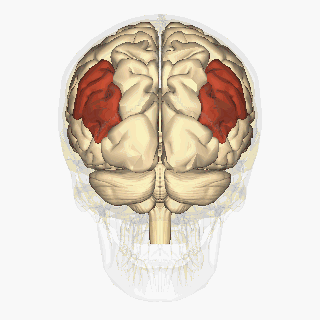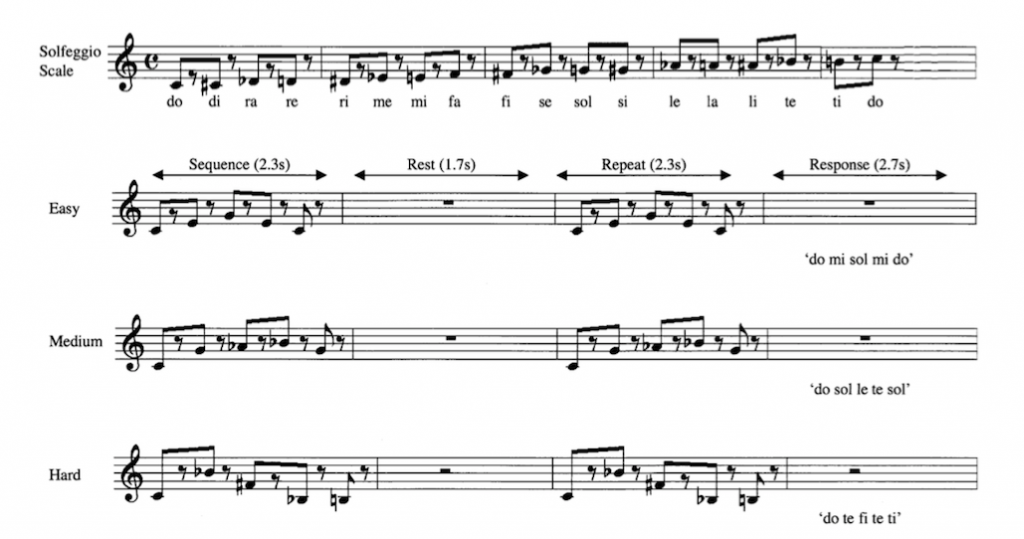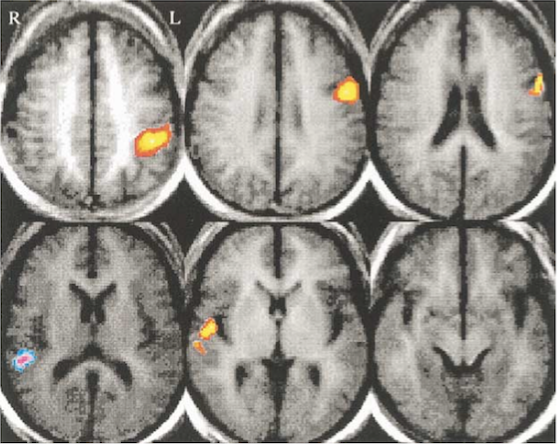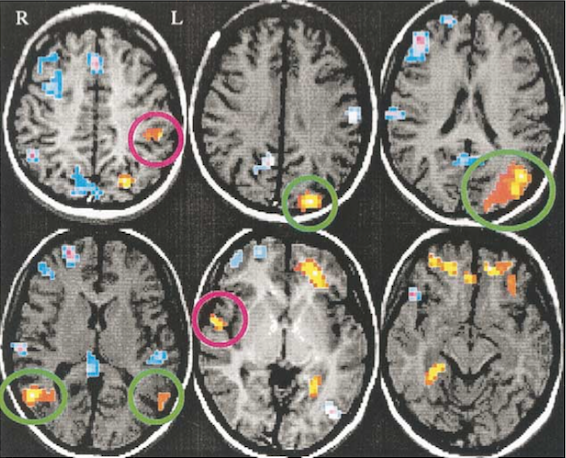Title of paper under discussion
Cortical plasticity in an early blind musician: an fMRl study
Authors
David A. Ross, Ingrid R. Olson, John C. Gore
Journal
Magnetic Resonance Imaging, vol 21 (2003) pp 821–828
Link to paper (free access)
Overview
Blindness is often reckoned to be associated with a high level of musical competence, “perhaps due to high profile individuals such as Ray Charles or Stevie Wonder”. The authors of this paper reasoned that such musical expertise may arise from “blindness-induced plasticity” whereby the brain grows and functions differently following “deprivation of sight and the subsequent reliance on audition [hearing]”.
Although the blind musician, and all the control participants, chosen for the study had absolute (perfect) pitch, the musical expertise under investigation was relative pitch naming, whereby participants – in a brain scanner – were asked to name notes (e.g. “re”, “mi”, “fa” etc) according to their tonal relationship to a given “do”.
The MRI scan results showed that in order to process this musical task the blind musician was recruiting a couple of brain regions in addition to those used by her sighted colleagues – regions associated with visual processing in sighted individuals.
Introduction
Though scientific studies normally involve as large a sample size of participants as possible to optimise statistical power, sometimes such numbers just aren’t available. This study, for example, set out to investigate blind musicians with absolute pitch, a type of person whose prevalence in the general population might be as low as 1 in 10 million. Hence David Ross and his colleagues chose to carry out fMRI scans on just a single case study (plus some sighted control participants), claiming that “while it is difficult to make broad conclusions based on a single individual, such data may still yield important insights into otherwise inaccessible phenomena”.
Past studies on brain activity in people with early blindness have revealed certain regions, regions known in sighted brains to process visual information, instead being “recruited to process both tactile and auditory stimuli”, a phenomenon known as “functional plasticity”. (Two such areas are the extrastriate cortex and the angular gyrus – see their locations in the brain in the pictures below). However, to the best of the authors’ knowledge, no studies had yet addressed the functional plasticity associated with musical expertise in blind people.


The type of musical expertise David Ross and his team chose to investigate was relative pitch naming. They had already studied the brain activity associated with relative pitch naming in sighted musicians possessing absolute pitch, and found a consistent pattern of activity involving the right auditory cortex, the left supramarginal gyrus (SMG) and the left inferior frontal gyrus (IFG).
What activity then might the authors find in the brain of a blind musician possessing absolute pitch carrying out a similar task? Activity in the same regions? In different regions? Or perhaps in the same regions plus the ‘recruitable’ areas illustrated above – extrastriate cortex and angular gyrus?
Method
The principal subject of the study, referred to by her initials ML, was an 18-yr-old trumpeter (and pianist) who was born with minimal vision and who reported having absolute pitch for as long as she could remember. Five sighted participants, all claiming to possess absolute pitch too, volunteered as controls.
As a preliminary check, the research team needed to be sure that all participants really did possess absolute pitch, so each was presented with 60 consecutive tones and asked to name each pitch.
For the experiment proper the participants entered an fMRI (functional Magnetic Resonance Imaging) scanner and were asked to complete a series of relative pitch naming tasks, using “moveable-do solfege”. Each experimental task, designed to involve “the ability to recognise the difference between different frequencies without regard to their absolute values”, consisted of a five note musical sequence. Participants were asked to designate the first note as tonic ‘do’ (whatever its absolute frequency – it could be any of the 12 notes in the chromatic scale) and then “to label the subsequent four notes based on their scalar relationship to the tonic”. The absolute pitch of ‘do’ was varied at random throughout the series of sequences, as was the difficulty level – easy, medium, hard. Here are some examples of this experimental task:

The experimenters were interested only in brain activity specific to relative pitch naming. So they devised a control task “similar to the experimental task in every regard except that subjects were required to compare stimuli to each other without the use of any tonal information”. Five bursts of “pink noise”, all of the same pitch but differing in their timbre, were presented. The timbres each had names (“bah,” “dah,” “fo,” “kah,” and “nay”) which the participants learned before the experiment, and each control sequence started with “bah” (just as the first note of every tonal sequence was ‘do’). The authors reasoned that if the brain activity pattern in the control task fMRI scan was subtracted from the brain activity pattern in the experimental task fMRI scan, the result “should reveal those regions of the brain that are involved in understanding the relationship between pitches”.
All participants closed their eyes throughout the experiment.
Results
All participants, ML and the five sighted controls, were successful in the absolute pitch test (especially ML, who scored 59 out of 60); and all achieved comparable marks in the moveable-do solfege tests (again ML scoring particularly highly, getting 98% of easy, 76% of medium and 50% of hard tests correct).
The fMRI scans of the sighted participants showed, as in previous studies, heightened activity in auditory cortex, left supra marginal gyrus (SMG) and left inferior frontal gyrus (IFG) whilst naming relative musical pitches:

Above: heightened activity in brains of sighted musicians (in red/yellow) whilst naming relative pitches (images are of six horizontal ‘slices’ of the brain)
In comparison, ML’s brain showed equal activity in these regions (auditory cortex, SMG and IFG)….plus heightened activity in two further regions: the angular gyrus and the extrastriate cortex. In her brain scans (below) the experimenters have circled the areas showing similar activation to those of sighted participants (auditory cortex, SMG and IFG) in pink, and the extra areas showing heightened activity in her brain alone (angular gyrus and extrastriate cortex) in green:

Discussion
As predicted, ML’s brain displayed functional plasticity in relation to the musical expertise of ‘relative pitch naming’, recruiting two extra brain regions – the angular gyrus and the extrastriate cortex – to process the task, in comparison to her sighted colleagues.
Looking at these two recruited brain regions more specifically:
The extrastriate cortex, in sighted individuals, plays “a critical role in integrating signals from the primary visual cortex”. In blind individuals it is instead recruited to process auditory and tactile information – although this experiment was almost certainly the first demonstration of its use in the processing of music.
The angular gyrus, in sighted individuals, contains “multimodal cells that are responsible for integrating signals from visual, somatosensory and auditory systems”. Such integration was not needed for the purely auditory experimental task in this paper, hence its lack of activation in the sighted musicians. However “in blind individuals these regions becomes dominated by non-visual systems and do not require visual stimulation to be activated” – hence the activation in ML’s experimental scans.
How come the brain of an early blind person allows music processing to ‘invade and take over’ an area normally reserved for visual processing? Ross and his colleagues suggest that it is not an invasion, reminding us of the theory that a toddler’s brain is not really segregated into “visual region”, “auditory region”, “tactile region” etc at all – in reality, all the different sensory modes are being processed all over the very young brain. But from the age of 6 -12 years old, different sensory modes (vision, hearing, touch etc) start ‘competing’ for control of certain brain areas, with connections belonging to the ‘losing’ senses dying off. Thus the brain only develops the specialised areas we recognise as ‘visual cortex’ , ‘auditory cortex’, ‘somatosensory cortex’ etc. due to the ‘death’ of the other sensory modes in those regions. In an early blind person, vision was not there to compete in the region that would in a sighted person become visual cortex, so instead auditory processing – specifically music processing in this case – stays put.
The authors concludes by telling us that ML, so far merely a ‘case study’, is in truth an “extraordinary” musician – “she learns all of her parts by ear and quickly memorises them. She is often able to play back an entire piece after hearing it only once or twice. She is also held in the highest regard by her peers for her mastery of many of the intangible aspects of musical performance.” The authors conclude that “in this regard, subject ML embodies the folkloric notion that because she is blind she has been able to develop superior musical abilities. Our data suggest a neurobiological basis for these reports. It is plausible that her remarkable musical aptitude may derive from the recruitment of visual cortical areas, thus allowing her to devote expanded neural networks to the performance of musical tasks”.
Coda
George Shearing – piano
Neil Swainson – bass